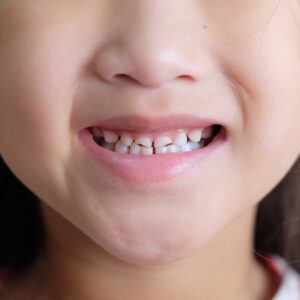
No matter how carefully you look after your child’s teeth, a single sports game, playtime at recess, or even just a bite of hardy can result in a chipped or fractured tooth. While the thought can be scary, broken teeth in young children are actually quite common and can happen from a variety of causes. If your child experiences a broken tooth, don’t panic! There are a few things you can do right away to treat the tooth, protect your child’s overall oral health, and prevent similar situations in the future.
What Are the Causes of Broken Teeth in Children?
Childhood is a fun and exciting time in which many children are learning and exploring new things and activities. However, it’s during this time that many of the most common causes of busted teeth can occur. Fractures to a child’s teeth can come from physical trauma like a fall while running or playing on structures like jungle gyms or monkey bars, impacts from other people or equipment while playing sports, or even punches in playground fights.
However, broken teeth can also result from biting into hard things that shouldn’t be in a child’s mouth, like toys, marbles, or rocks for example. Even ice cubes or hard candy can cause accidental chips and fractures. Tooth fractures should always be taken seriously, even if they occur in “baby teeth” that will fall out on their own—but not all fractures are created equal. There are different classes of fractures that your dentist may use to categorize your child’s injury:
Class 1 includes fractures or chips in the outer enamel layer. For smaller chips, your child’s dentist may simply smooth over the rough edge, or use a composite filling for larger chips.
Class 2 includes larger fractures into the dentin layer. The result might be an increased sensitivity to hot and cold as inner structures of the tooth are now exposed to external stimuli. A large fracture may require a crown or porcelain veneer, though this is uncommon with very young children.
Class 3 includes fractures into the tooth’s pulp. Because of the increased risk of bacterial infection to the tooth’s root and nerve, these cases often require special attention. Children have an increased probability of healing on their own because they often have a healthier blood supply to their teeth than the average adult. However, in permanent teeth, a root canal may be required to hold a dental crown.
Class 4 includes fractures of the tooth root. These are the least common, yet most serious types of fractures and almost always require complete removal of the tooth.
Any of these types of fractures should be considered pediatric dental emergencies and require treatment from a dentist as soon as possible. However, there are steps you can take to ease your child’s pain and prepare them for treatment in the meantime.
What to Do Immediately After Your Child Breaks a Tooth
The moments directly after any kind of tooth fracture can be nerve-wracking, and your child will probably experience some pain. However, chipped baby teeth or permanent teeth are not life-threatening, and by keeping calm and remembering a few basic treatments in this crucial time you can treat your child’s pain, minimize the risk of infection, and potentially save their teeth! The American Dental Association and the American Academy of Pediatrics recommend that you should:
Save the Fragmented Tooth if Possible
Try to locate and save the missing piece of your child’s tooth. Sometimes your dentist may be able to bond the piece of tooth back in place, negating the need for reconstruction. Keep the piece of tooth moist by wrapping it in a wet cloth or piece of gauze, or keeping it submerged in a cup of milk or even saliva.
Oral Rinse
Remove any debris with a piece of floss and not a sharp instrument. Give your child a glass of warm water to rinse their mouth out with.
Cold Compress
If your child’s broken tooth is the result of physical trauma, there may be some swelling around the impact site. Wrap a bag of ice in a thin cloth and give it to them to hold against the affected site for a few minutes at a time.
Pain Management
Administer children’s Tylenol, acetaminophen, or other appropriate over-the-counter pain medication if necessary to control pain.
Contact Your Dentist
With chipped, cracked, or missing teeth, it’s important to contact your child’s dentist immediately. After explaining the situation to them, they will help you schedule an appointment as soon as possible to see if the broken tooth can be saved, or perform any other necessary treatment.
Meeting With Your Dentist
When your child sustains a fractured tooth, it’s important to find a dentist that specializes in Children’s Pediatric Dentistry. Pediatric dentists understand the unique physiology of children’s mouths, as well the psychological components of treating children. Depending on the extent of the damage, your child’s dentist will decide on the best course of action. This may be as simple as rounding over the rough edge of a minor chip, or, if the root has been affected, your child may need a root canal or crown placement.
Getting your child to a qualified pediatric dentist immediately after breaking a tooth both increases the likelihood of saving the affected tooth and minimizes the need for more extensive treatment later. While it’s stressful to support your child through a pediatric dental emergency, the professionals at Champagne Pediatric Dentistry have years of experience in treating broken teeth and helping children regain their smiles—as well as dental tips to keep your family’s mouths healthy. Contact us in the event of your child breaking a tooth, and let us help your family through the entire treatment and healing process.

